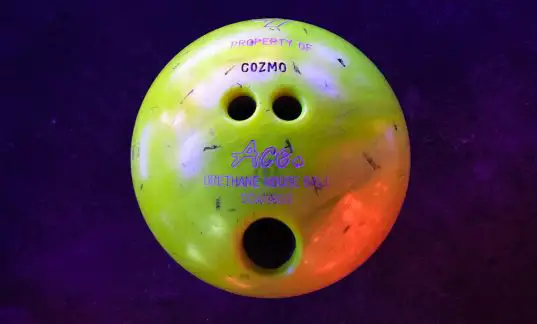Asymmetrical bowling balls
If you’ve only played with house bowling balls before, you’ve likely only played with symmetrical bowling balls. Asymmetrical core technology is a completely different beast altogether. An asymmetric bowling ball revels in its violence and wild ball reaction, causing an end reaction unfamiliar to the typical smoother symmetrical ball options you’re familiar with.
Asymmetrical core bowling balls are usually high-performance ball offerings built for studied bowlers in need of an angular, booming pin impact boost. During the ball construction process, bowling equipment manufacturers take special care to fashion each asymmetrical ball for a pin-busting purpose.
But, what do asymmetrical cores mean for a bowler? How do an asymmetric ball and a symmetric ball differ? When is it better to use a symmetrical core compared to an asymmetrical core?
Let’s take a deep dive into the wonders of asymmetric core technology and how asymmetric cores have changed the game of bowling as we know it.
5 Key Questions About Asymmetrical (And Symmetrical) Bowling Balls
What is an asymmetrical bowling ball?
Advancements in bowling coverstock technology have dramatically altered how bowling balls perform at the lanes. When you read up on the latest bowling ball standout that features a hybrid reactive or pearl reactive coverstock, you’re reading about a revolution in the sport.
However, while aggressive coverstocks offer more aggressive movement, they’re not alone in changing bowling technology as we know it.
Asymmetrical bowling balls have opened up infinite possibilities for the creation of low RG balls, high RG balls, very low flaring ball, and high flaring ball options. Creating uniformity out of chaos, the countless different asymmetrical core shapes in the marketplace right now fundamentally alter ball performance down-lane.
By changing the shape of a core and altering how weight is displaced when a ball rolls, the maximum and minimum RG values are pushed past their symmetrical limits. And how an asymmetrical ball is drilled in terms of its positive axis point and pin-to-PAP distance go a long way in determining its track flare potential and overall ball motion.
What’s the difference between symmetrical and asymmetrical bowling balls?
An asymmetrical bowling ball is built with a core that eschews symmetry for something more creative. Asymmetrical balls have an undrilled intermediate differential that is not present in symmetric bowling balls. This is due to an added variable of an extra axis point. Symmetric bowling balls have a high and low axis, with true differential and RG values being the only measurable elements of their performance.
With the addition of a third variable in intermediate differential, asymmetrical bowling balls have X, Y, and Z axes instead of just X & Y axes. This added axis promotes a strong mid-lane reaction, a sharper breakpoint reaction, and a customizable approach to total differential and Radius of Gyration.
Instead of relying on the controllable motion and typically smoother tracks of symmetric core options, asymmetrical balls add flare potential and a preferred spin axis that turns things sideways headed towards the pins. And different drilling layouts take advantage of these elements in different ways. The stronger the placement of its preferred spin axis (PSA), the higher the flare potential and the more wild things can get.
When should I use an asymmetrical bowling ball?
If you want a very high flaring ball and a long pin-to-PAP distance that brings violent angularity, a properly-drilled asymmetric bowling ball is for you. Coupled with an aggressive cover stock, an asymmetrical core will give you an array of entry-angle options not present in symmetric bowling balls.
Use an asymmetrical ball when you want to augment your hook shot with added back-end oomph and sudden directional shifts. Most expert bowlers prefer an asymmetrical bowling ball as their strike ball option, especially when oil conditions are complex and drastic measures are needed.
When should I use a symmetrical bowling ball?
Symmetrical bowling balls are much more predictable in their pathways to the pins. If you are a straight-line bowler or need a spare option that hits the pins the same way each time, symmetrical cores are the way to go. You won’t have to deal with the added variable of a preferred spin axis and you’ll be able to find a singular groove to your sweet spot with a symmetric ball.
5 Tips For Better Ball Motion With Asymmetric Bowling Balls
1) Use the best asymmetrical bowling balls to conquer complex lane conditions.
Because of their distinct ball motion and ability to change directions on a dime, asymmetric bowling balls are often perfect for complex and deep oil conditions — especially when paired with a reactive resin coverstock. Throw a few test shots on short or long oil patterns to see how your hook shot reacts with the aid of an asymmetrical core. Alter your approach as necessary and use the added positive spin axis to hit the pins from a variety of creative angles.
2) There’s a critical difference between more ball motion and predictable motion.
Symmetrical core bowling balls usually offer a predictable motion that can be repeated with little to no trouble. Asymmetrical bowling balls offer more ball motion that’s harder to tame and calibrate. Use this to your advantage by leaning into the chaos, pushing your shot with more speed and finger rotation for even more dramatic results. More drama could mean more pin carry.
3) Brace for a sudden angular motion at the break point with asymmetrical balls.
Oftentimes, asymmetrical balls provide a sudden 180-degree shift in direction at the breakpoint. You have to be aware of this and use this knowledge to find your angle into the pin pocket. If you keep hitting the pocket too high or too low (or keep missing it altogether), alter your approach and finger rotation to get things right.
4) Asymmetrical balls can add to ball speed down the lane, so be prepared.
The mid-lane and down-lane theatrics of a properly-drilled asymmetrical ball is akin to fireworks. They are beautiful to look at but can be dangerous when used incorrectly. The added speed and angularity provided by some asymmetrical balls is a license to do major pin damage. However, you have to channel these added boosts into actually pin carry with a measured, smart throwing motion.
5) Symmetrical balls just can’t compare to asymmetric track flare, so be mindful.
The variances in ball paths provided by asymmetrical bowling balls are completely different from those provided by symmetrical bowling balls. In short, you can do much more with an asymmetrical bowling ball — especially if its coverstock is good at absorbing oil and turning it into added energy. If you’re a straight-line bowler, such track flare and movement will be daunting. If you’re a hook artist, these variables can be your best friends or your worse nightmares in terms of control and scoring averages. Work with your asymmetrical bowling ball and not against it. The more you learn its charms, the better off you’ll be during your league nights and tournament showcases.
Closing Thoughts
When you play with an asymmetrical bowling ball, you open up your game to an array of new possibilities. Asymmetrical cores give you new routes to the pins, new energies to use when you get there, and a variety of different hook shapes unavailable with symmetrical bowling balls. The more you learn how asymmetrical core technology works, the more you can do with it. If you like getting angular and wild with your throws, try out an asymmetric ball as soon as you can. You won’t be disappointed by the experience.

